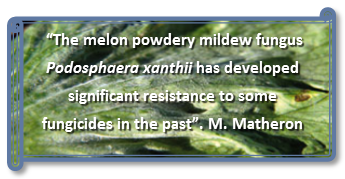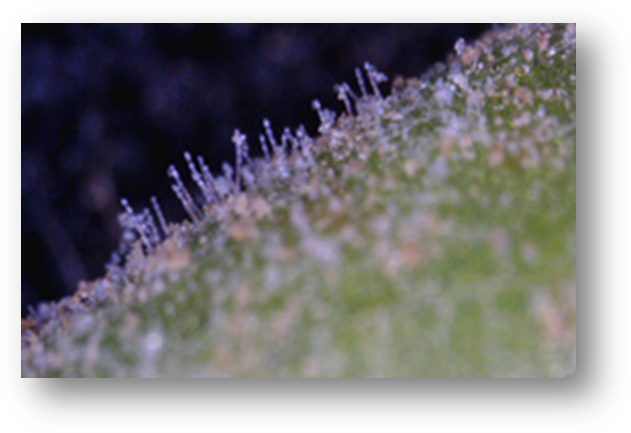
What is the best way to combat powdery mildew in melon plantings? Maximum disease
control requires initiation of a fungicide application program when environmental
conditions favor disease development but before the first visible detection of disease.
Less than optimal but good levels of disease control can also be achieved by beginning
fungicide applications at the very first sign of disease in the field. Early initiation
of fungicide treatment on susceptible melon varieties is essential due to the rapid
development and spread of powdery mildew from the initial and usually undetected
infection sites within the crop. Application of a newly registered novel active
ingredient usually is effective on virtually all of the individual pathogen spores
or colonies developing from spores. However, the very small number of individuals
not killed or inhibited by the fungicide will become an increasingly larger proportion
of the pathogen population as the use of the same active ingredient increases. This
is how resistance to a particular fungicide develops within the pathogen population.
The melon powdery mildew fungus Podosphaera xanthii has developed significant resistance
to some fungicides in the past. An important strategy to delay development of fungicide
resistance is to alternate among or mix products with different modes of action.
Previous research demonstrated that fungicide application sequences containing a
highly efficacious fungicide alternated with a product of lower efficacy provided
a final level of disease control not significantly different to that achieved by
continuous application of highly effective compounds. Data from these trials support
the notion that high levels of disease control and resistance management can be
realized with fungicide alternation programs containing different modes of action
of only highly effective chemistries as well as application programs incorporating
products with high efficacy along with those that are less effective. In the most
recent (2014) fungicide evaluation trial conducted at The University of Arizona
Yuma Agricultural Center, tested fungicides that reduced the leaf area covered with
powdery mildew on Olympic Gold cantaloupe plants by at least 90% compared to nontreated
plants included Luna Sensation (fluopyram+trifloxystrobin), Mettle (tetraconazole),
Procure (triflumizole), Quintec (quinoxyfen), Rally (myclobutanil), Rhyme (flutriafol),
Torino (cyflufenamid), and Vivando (metrafenone). These findings should reflect
efficacy on melons other than cantaloupe as well, since powdery mildew on all melons
in the desert southwest is caused by the same pathogen. Some of these tested fungicides
are not currently registered for use on melons, so read labels carefully before
considering their use.





